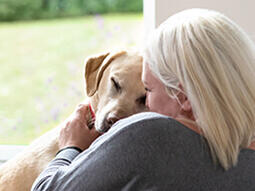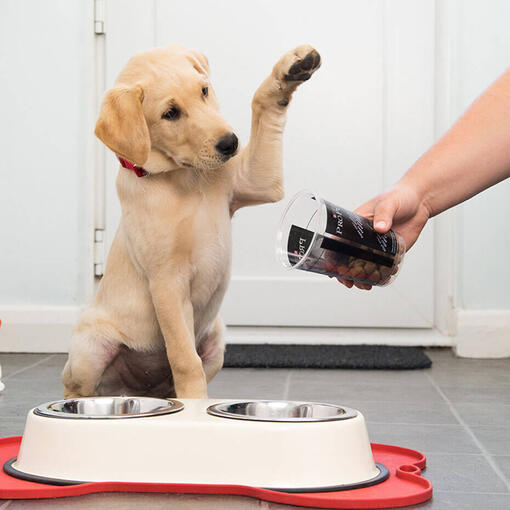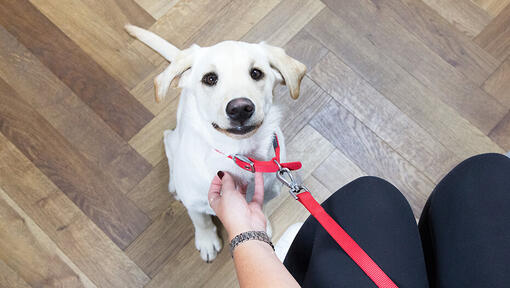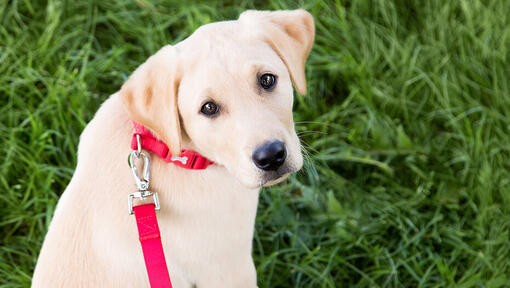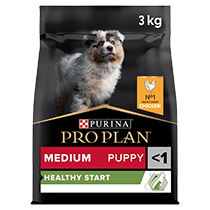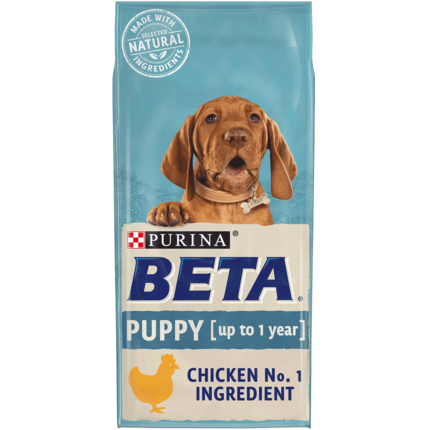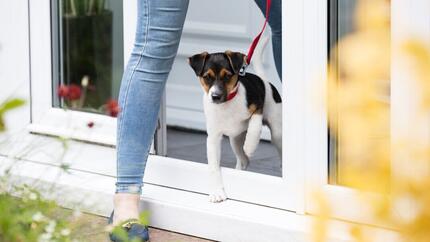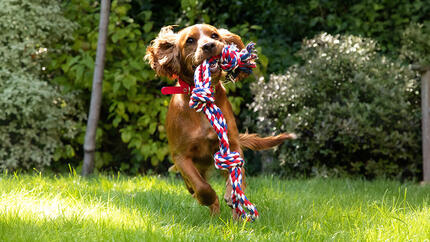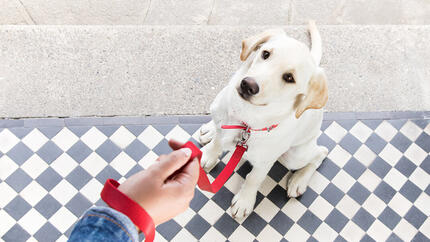

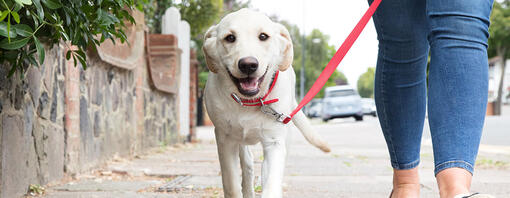
There’s little more frustrating than a dog who won’t stop pulling on the lead. It can be extremely tiring for both you and your pup, can become dangerous or even cause lasting damage, and can turn a simple walk into a complete nightmare. This is why teaching a puppy to walk on a lead is important.
In their excitement to get places, their joy of being in the great outdoors, and the thrill of having another adventure, many dogs pull on the lead. While every dog can get excited at times, if your dog refuses to walk without constantly pulling, it means that instead of you being able to walk with them happily staying beside you on a loose lead, you are controlling them with nothing more than physical restraint.
The lead should be there for safety, and it is your puppy training that should keep your dog walking close to you – not be something you have to hang on to with all your strength!
If you are relying on the lead, the physical effort involved in controlling your dog could be overwhelming – and even get dangerous for you both, especially if your canine friend is one of the larger, stronger breeds.
Teaching your dog to walk on a loose lead isn’t difficult – especially if you start when your dog is a puppy – and with a bit of work and a lot of consistency, you can both look forward to a lifetime of fun, enjoyable walks together.
Keep reading to find out how to lead train a puppy.
Why lead training puppies is important
Exercise
Being able to walk your puppy on a lead provides an opportunity to exercise your dog and keep them fit and healthy while they grow and mature, and throughout your life together. Many behaviour problems can be solved or reduced by making sure your dog gets enough appropriate exercise.
Mental stimulation
Lead training puppies allows them to observe new and interesting things about the world around them. Exposing your puppy to new sights, sounds, smells and environments is essential to their socialisation, growth and development, and so walking on a lead is essential to exploring all these new places together.
Most dogs spend long periods of time in the home – and that can get boring! Walks are the perfect time to experience new sights, sounds, scents and environments. They break up the day in an exciting way – and one where they get to spend quality time with you too. Puppies need all kinds of positive experiences to help them develop into well-balanced dogs who are happy with all the things they will encounter in their day-to-day life.
Exposing your puppy to new environments is important to their growth and development, and as they need to be safe and under control at all times, walking on a lead is essential for this.
Safety
There are many places you will want to go with your dog where having them on a lead will mean you can keep them safe – and other places where it will be important to keep people, other dogs, and livestock safe from your dog.
Further puppy training
All the exercises you will train your dog to do – sit, down, wait, come etc – will all need to be taught outside in the real world as well as at home or in the garden. Having a dog who will walk calmly on the lead gives you the opportunity to do this as part of your ongoing training.
A dog who has been trained to walk on a lead properly will, as part of that training, check in with you frequently and so will listen to you far more than if they spent all their time straining on the lead and largely ignoring you.
Social responsibility
When you are out and about with your dog, you owe it to others to be in control and not have an unruly dog (however friendly or cute) charging up to other dogs or people. This means that there are going to be times, even in safe open spaces, when your dog has to be on the lead.
Livestock
Any time you are in the countryside, you need to have close control of your dog – and (especially around sheep) that means on a lead.
What you’ll need before you start puppy leash training
Buy a harness that fits your puppy without slipping and that they can’t back out of. It should be of a design that doesn’t go across the puppy’s shoulders and restrict their movement – and that is well padded and comfortable.
It used to be that a puppy would be taught to walk on a collar but now we know that a harness is the best way to make this a positive experience for your dog and still give you all the control you need.
Every puppy can get bouncy at times and learning not to pull and to walk nicely is an ongoing process and so mistakes will be made. You don’t want those mistakes where, in their excitement and inexperience, your puppy can’t help but bound off and pull, to have all the force of the lead focused sharply around such a sensitive and delicate area as their throat.
A harness doesn’t make loose lead training any easier or any harder – it just means that the chances of hurting or injuring your puppy while they are learning are less.
A collar
You will still probably want a collar on your puppy however to attach their ID tag to (which they must by law wear in a public place). This should be soft, and comfortable with an easy (and quiet) fastening clip or buckle. When fastened you should be able to get two fingers between the collar and your puppy’s neck.
Treats
As with all your training, you will be using high-quality treats to help your puppy understand what you want, and to reward them when they get it right. When you think about it, walking on a lead is a totally unnatural thing for a dog to do, so you need to be generous with the praise and the rewards.
A lead
When training your puppy or dog to walk on the lead, using a long leash can be a great way to start. Find a 2m (6ft) training lead that has a clip at both ends and is not too heavy for your pup or uncomfortable for you to hold. A lead of this length will mean you can keep your puppy safe and close to you but still give them a bit of flexibility – as the objective is that they walk on a loose lead, not that they are glued to your leg in some kind of old-fashioned military exercise!
Walking close beside us for any length of time (as you see in obedience competitions) takes a high degree of training, and also, if you are to avoid putting strain on joints and bones, a high level of fitness and balance. Dogs naturally move at a very different speed from us and to slow down to our speed takes serious concentration and physical development.
Make sure that the lead can be attached securely to your puppy’s harness.
Remember: the object of puppy lead training is that your dog will walk on a loose lead – forget about obedience style ‘heel work’ as this is an advanced exercise, and you would be just setting you and your dog up to fail, and to endless frustration.
How to train a puppy to walk on a lead
There are a few easy ways to successfully train your puppy to walk on a lead. From choosing the right harness to remaining consistent with rewards. Puppy leash training is a vital part of your puppy’s growth. To train your puppy to successfully walk on the lead, follow these steps:
Your puppy can’t pull if there is nothing to pull against, and you are both learning from the very start how to work together.
Start early when you are in the house and long before you put a harness or a lead on. You are going to be teaching your puppy that walking beside you is a good thing.
When you are doing some training with your puppy, hold a treat close to the end of their nose so they can smell it, and walk a couple of steps forward encouraging them to come with you. After two or three steps, stop, tell them how good they are, and give them the treat.
Make it into a game, be enthusiastic and have fun with this. If they get ahead of you or wander off, stop, use the treat to lure them back to you and carry on walking (and remind yourself to be more enthusiastic and get better (smellier!) treats!).
Practise this several times a day in different rooms and at different times – so your puppy learns that walking with you is rewarding. Once your puppy can do this in the house, move into your puppy-proofed garden (ie your garden is fully fenced and enclosed).
You can begin to build up the distance you can walk - and reduce the amount of time you need to lure with the treat. The aim is that you show your puppy you have a treat – and then just walk a few paces without them needing to follow the treat - but of course still getting rewarded at the end.
Spend time finding a soft harness that your puppy is going to be very comfortable in. This shouldn’t rub anywhere and shouldn’t come across the front of the shoulder as that can restrict the puppy’s movement. Introduce it to your puppy just by sitting on the floor and letting them sniff it. This can be paired with treats and praise to build up positive associations. Don’t let them bite or chew it though.
When your puppy is happy with what the harness looks and smells like, you can put it on, give them a treat and/or play a game – and then take it back off again. Practise this several times a day (long before your puppy is allowed to go outside) so that they are totally used to the harness.
Now and then, lightly pull on the harness so they get used to that feeling too – always pairing that with praise and treats. Most puppies have worn a puppy collar while still with their breeder but you can get them used to the collar exactly the same way.
Don’t forget that puppies grow fast so check the fit and the sizing of both the harness and the collar every day.
Before walking your puppy, the first step is to repeat the ‘walking beside you without a lead’ training you did in step 1 but with the harness on.
That seems like a small thing but for a puppy, moving with a harness will feel very different. This will need great treats and plenty of them to distract your puppy from the new sensations and make sure they are still having fun.
Once they can do this happily, it’s time to add the lead. Start with a very lightweight lead – maybe even a houseline – that your puppy will hardly even realise is there.
Attach the lead to the harness – but don’t pick it up yet.
Go right back to practising your ‘walking beside you without a lead’ with the lead either trailing or else held very loosely in your hand (you might have to do this if the lead looks like something exciting to play with!).
Then pick up the lead but follow your puppy wherever they want to go. This is about getting used to the feeling of being attached to you. Keep giving frequent rewards and praise so that your puppy learns that being on the lead is a great thing!
It’s important to make the lead seem fun and rewarding so your puppy looks forward to you putting it on. Once the lead is on, you can use treats or toys to entertain your puppy. By association, your puppy should anticipate fun once you put on the lead.
Once your puppy is happy moving around the house and the garden with the harness and lead on – with you following them – practise the Watch Me exercise every few minutes.
Just stop, say your puppy’s name, and when they look at you, give them a treat and then let them continue exploring/walking.
Being able to get your puppy to look at you when you say their name is going to be invaluable when you get out into the great outdoors with all the distractions they are going to encounter. This will mean the difference between working together and your puppy ignoring you and focusing solely on all the exciting things that are going on around them.
As always, reward successes!
The secret to good loose lead walking is not to rush all these steps. This preparation means the difference between a puppy who thinks leads are for pulling on and one who has learned to keep it loose. Practice some gentle tugging.
Once your puppy is happy walking with their harness and lead on – with you following behind – you can start to get them used to the sensation that sometimes you will need to have pressure on the harness from the lead (for safety, steering and for those inevitable times when your puppy gets so excited or engrossed in something that they pull on the lead).
So, while you are following your puppy, stop, turn round and call your puppy to you. If they come, fabulous. If they don't, add a little bit of pressure – without jerking or pulling. As soon as they follow, relax the lead totally and reward them when they come to you.
Keep practising this – and all the other steps up to this point – until your puppy is fully vaccinated and allowed to go out.
Your first puppy walks
This is an exciting day! This is the day you will put your puppy lead training skills to the test. It is the first time you can take your puppy out on a lead and you will be full of enthusiasm and maybe even planning a long stroll together.
For your puppy, this can be anything from wildly exciting to terrifying – and so your first walks need to be nothing more than quiet explorations.
This will be a new experience for your puppy. There will be lots of new sights, sounds and smells for them to encounter – and so you need to give them time to explore and experience this new world. That is how they learn and discover that all these new things are nothing to worry about and are just part of their new life. Plus of course, even at 14 weeks old, they are still babies and only able to do very short walks. Make sure you are not pushing your puppy too far, especially when exercising them, you don’t want them to dislike walking!
Let your puppy dictate how fast you go when you stop to sniff and explore, and when you go home. This might only be a couple of minutes where you don’t get much further than the front gate – or it could be half an hour.
What to prepare
- Always carry treats with you and reward your puppy every few meters when the lead is loose
- If the lead gets tight, stop and wait. When your puppy looks at you, call them back to you, give them a reward and continue.
- Give your puppy plenty of chances to stop and sniff – or even to stop and take in whatever is going on around them. This is how they find out about the world and everything is new for them
- Start your first walks in a quiet area where there are fewer distractions and not many people or other dogs. This might be just outside your home or you may need to travel to a quiet place.
- When your puppy isn’t distracted, practise the ‘Watch Me’ exercise in this new environment.
Remember that legally your puppy must have an ID tag when out (not just a microchip).
Next steps in loose lead puppy walking
Once your puppy has got over the excitement of being outside and going for walks, and is happy on their harness, you can start to work a little more on your loose lead walking and reduce the amount of treats you are giving as well.
- Give your puppy a couple of treats before you set off – just to focus them on you and remind them that you have ‘good stuff’.
- Then start your walk.
- Let your puppy take time to sniff and explore (remember this is their walk!) but mostly just walk to wherever you are planning on going.
- Your aim is that the lead stays loose at all times. It doesn’t matter if your puppy isn’t right beside you, just that the lead isn’t tight.
- If it gets tight (because your puppy has gone ahead or is lagging behind), stop and wait. When your puppy looks at you, call them back to you, give them a treat and keep walking. You need to be really consistent in this and teach them that they will only get somewhere by doing it on a loose lead.
- If they are lagging behind because they are worried about something, give them time to observe what it is and decide it isn’t scary. Don’t drag them or force them to move.
- Practise ‘Watch Me’ quite regularly – just so your puppy keeps their focus on you.
- Start to introduce changes of direction into your walking. Do this without pulling. Get your puppy’s attention, call them to you, and as they come towards you, turn and keep walking so they follow you.
- You can also do changes of speed the same way (sometimes walking faster, other times, creeping!).
- Make all these changes of direction and speed, fun and a game.
- Do not think of this as ‘heelwork’, just that your puppy will walk beside you without the lead being tight – even as you change direction and speed.
- Reward frequently – and don’t try to do too much too soon.
Meeting people and other dogs
Once you have mastered this on your own, a good puppy training class will be an ideal way to teach your dog to walk nicely around other dogs and people.
Your aim will always be that your puppy can pay attention to you and ignore others dogs, not drag you over to them wanting to say hello!
Meeting up with friends for a walk is a great (and social) way to do this too. Just meet in a nice open space with both dogs on the lead as usual, and just walk parallel together. Start off not too close, so you can keep your puppy’s attention on you and as the dogs get used to each other’s company, you can walk a little closer.
Again, this is an exercise in loose lead walking not a play date.
When teaching your puppy to walk on a lead, it is always good to teach them to walk with you. By teaching them to walk with you despite distractions, will transform your walks – especially when they get bigger and stronger!
Random rewards
Once your dog is happily and reliably walking on a loose lead, reduce their rewards and only give them the occasional treat for especially good lead-walking (such as calmly passing an exciting distraction). Don’t stop giving rewards altogether – a random reward will keep your dog’s interest and concentration.
Keep practising ‘Watch Me’ and always reward those.
Start to use the ‘Watch Me’ to take your puppy’s focus away from distractions so you can pass them calmly.
How to stop puppy from pulling on the lead
If your dog is pulling on their lead and you find it hard to stop them, follow all the steps above. If this isn’t working, consider finding a qualified accredited trainer to help you.
Never be tempted to use a choke chain (a ‘check collar’) or a prong collar.
Walks should be fun for you both and training should always be a positive, reward-based experience that encourages bonding between you, not punish them in a way that can cause pain and fear and inspire – and damage the trust between you.
Tips for loose lead walking
1. Carry treats with you
Use dog treats to reward them for good behaviour on the lead
2. Find a quiet area
Since most puppies are very excitable and full of energy, it’s best to find a quiet area to teach your puppy how to walk on a lead in the initial stages. Once your puppy has become more used to walking beside you, you can move into busier places (e.g. parks with other dog walkers).
3. Start teaching them how to heel on the lead
The most important thing is keeping in your head what success looks like! Forget obedience-style heel work. That is hard work and is unnatural for a dog. They move at a different speed to us and slowing down to walk beside us can be difficult and uncomfortable (or for tiny dogs, having to run to keep up is just as hard).
The aim is to have a dog who walks beside you on a loose lead. It really is that simple. If the lead is loose, reward them. If it gets tight, stop, call them back to you, reward them and continue.
4. Be patient
Remember that walking on a lead is a new experience for your puppy and, for this reason, it’s important to be patient and to remember that this is an exercise that will take months to fully learn and will be an ongoing process, and it’s not something that can be taught in a few hours.
For a dog the world is an exciting place, a lead isn’t natural, and there are lots of things to do and to investigate – and so there will be plenty of slip-ups along the way.
Just stay calm, don’t be tempted to pull or tug on the lead yourself, and resist the temptation to think ‘oh it won’t matter if I let them pull today’ (especially if you are in a hurry!). Your dog has to believe that they won’t get anywhere on a tight lead.
Consistency is key – and remember it takes two to pull!
Top tips for lead training puppies on a loose lead:
- Practice loose lead walking in many short training sessions, and remember to reward frequently when your dog walks alongside you on a loose lead
- If your dog pulls ahead while walking on a lead, it’s because they want to get somewhere, something has got their attention or they are just getting fed up of walking at your slow pace! Stand still, call them back to you, reward them, and start again.
- Life, and the great outdoors, is really exciting, especially to a young dog, so walking, especially in these first few months, might involve a bit of puppy pulling and a lot of patience and consistency from you. With a bit of work though this will get easier and your puppy will begin to understand that pulling on a lead is counterproductive to getting anywhere.
- NEVER be tempted to jerk back on the lead or use a check chain or prong collar. Causing your puppy pain or discomfort is never the answer. Research shows that not only can this cause injury but linking exercise with pain can cause a whole host of behaviour problems with your dog.
That’s our guide for how to train a puppy to walk on a lead. No matter what point you’re starting from, with a little love, encouragement and patience, you will be able to go on some truly memorable and special journeys when walking your dog. If you’re looking for even puppy training and behaviour advice, check out our puppy manners, chewing, mouthing and jumping up guide.

